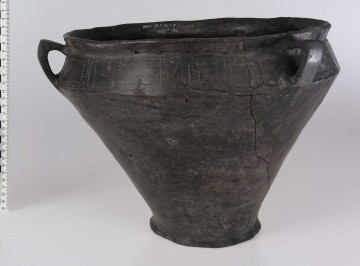
Vessel
National Museum in Lublin
Part of the collection: Set of archaeological relics found in the Lublin Region
The two-cone vase from Werbkowice-Kotorów is a vessel of ideal proportions, made using a potter's wheel. It belongs to a set of vessels from a grave furnishing from the late Roman period (the end of the 3rd - 1st half of the 4th century AD) discovered in a multi-cultural settlement. Research at the site was undertaken in 1959 by archaeologists from the State Archaeological Museum in Warsaw. The relics from the excavations, after being processed, were transferred to the collection of the Department of Archaeology of the National Museum in Lublin.
The mentioned grave with vessels is a burial of a young girl (about thirteen years old), with whom the grave gifts were found - nine vessels, seven of which represent high quality turned pottery, a glass vessel, a silver clasp and a clay rattle.
The vase has a well-defined small foot; the top of the vessel is biconical, with the largest protuberance. The transition from the body to the neck is marked with a rounded convex strip. The upper part of the belly is ornamented with a row of smoothened "Xs" (ixes). The surface of the vessel is smooth, even shiny.
The grave in which the girl and her gifts were buried may be associated with the community of the so-called Masłomęcz group, which in the younger Roman period (3rd and 4th centuries AD) created in the Hrubieszów Basin a highly developed civilisation, a kind of trading emporium, where luxury goods such as earthenware made using the potter's wheel were exchanged.
Author / creator
Dimensions
cały obiekt: height: 11,5 cm
Object type
dish
Technique
rolling
Material
clay
Creation time / dating
Creation / finding place
Owner
The National Museum in Lublin
Identification number
Location / status